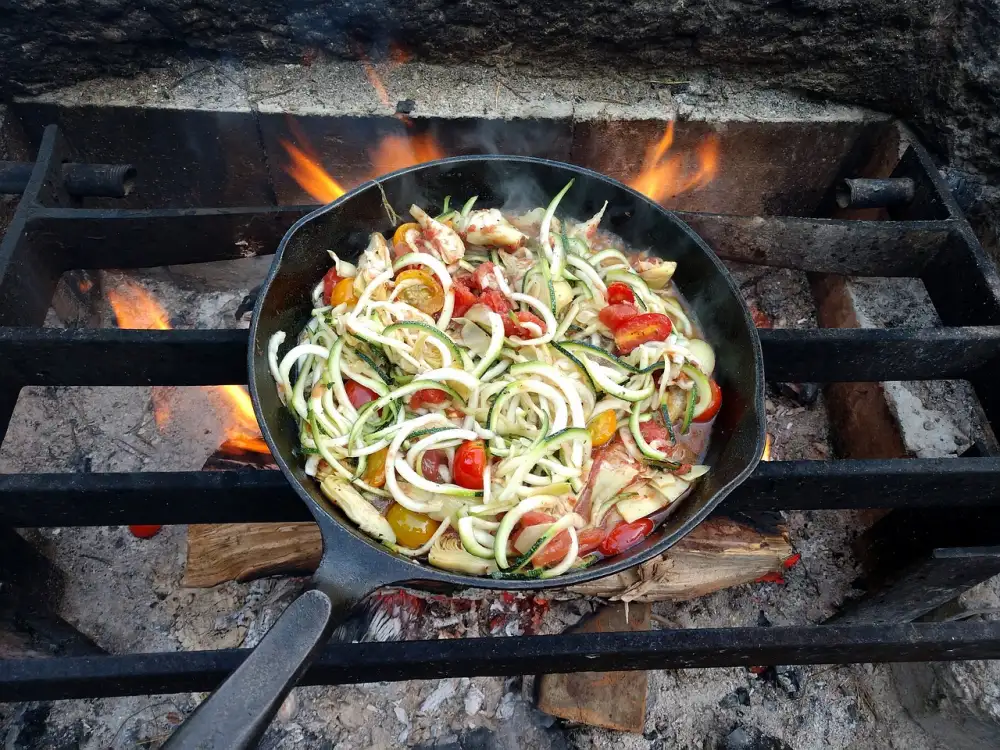Revive Your Cast Iron Skillet: Master the Art of Cleaning a Cast Iron Skillet at Home

A cast iron skillet is a beloved kitchen tool that can last for generations if properly cared for. Regular cleaning is essential to maintain its longevity and ensure optimal cooking performance. Not only does cleaning remove food residue and prevent the buildup of harmful bacteria, but it also helps to preserve the skillet's seasoned surface, which imparts incredible flavor to your dishes. In this article, we will guide you through the art of cleaning a cast iron skillet at home, so you can enjoy its benefits for years to come.
Gather necessary supplies for cleaning
To effectively clean a cast iron skillet, it is important to gather the necessary supplies beforehand. You will need a stiff brush or sponge, mild dish soap, kosher salt, white vinegar, baking soda, paper towels or clean cloth, and cooking oil (preferably vegetable or canola oil). These supplies will help you tackle any dirt, residue, or rust that may have accumulated on your skillet over time. With these items at hand, you'll be well-equipped to restore your cast iron skillet to its former glory.
Preparing the cast iron skillet for cleaning
Before you begin cleaning your cast iron skillet, it's important to prepare it properly. Start by removing any leftover food or debris from the skillet. You can use a stiff brush or a plastic scraper to gently scrape off any stuck-on bits. Avoid using metal utensils as they can scratch the surface of the skillet.
Next, rinse the skillet under warm water to remove any loose particles. Avoid using soap at this stage as it can strip away the seasoning of the skillet. Instead, rely on hot water and gentle scrubbing to clean the surface.
If there are any stubborn stains or residue, you can create a paste by mixing equal parts of salt and water. Apply this paste to the affected areas and scrub gently with a sponge or cloth.
Once you have removed all traces of food and stains, rinse the skillet thoroughly with warm water again. Make sure to remove all traces of salt or cleaning paste.
Now that your cast iron skillet is prepared for cleaning, you're ready to move on to the next step: actually cleaning it using gentle methods.
Cleaning the cast iron skillet using gentle methods
Cleaning a cast iron skillet requires gentle methods to avoid damaging the seasoning. Start by rinsing the skillet under warm water and using a soft sponge or brush to remove any food residue. Avoid using soap as it can strip away the seasoning. For stubborn bits, create a paste with coarse salt and water, and gently scrub the skillet. Rinse thoroughly and dry immediately to prevent rusting. Remember, never soak your cast iron skillet or use abrasive cleaners, as they can ruin the surface.
Removing stubborn stains or rust from the skillet
Removing stubborn stains or rust from your cast iron skillet may seem like a daunting task, but with the right techniques, it can be easily accomplished. One effective method is using a mixture of salt and oil. Sprinkle a generous amount of coarse salt onto the surface of the skillet, then pour a small amount of vegetable oil over it. Using a scrub brush or a paper towel, vigorously scrub the stained areas until the stains start to lift off. Rinse the skillet thoroughly and dry it completely.
For tougher stains or rust, you can create a paste by mixing equal parts baking soda and water. Apply this paste to the affected areas and let it sit for about 15 minutes. Then, using a scrub brush or steel wool, gently scrub away the stains or rust. Rinse well and dry thoroughly.
Another method to remove stubborn stains is by using vinegar. Fill your sink or a large container with equal parts water and white vinegar. Submerge the skillet in this solution and let it soak for at least one hour. After soaking, use a scrub brush to remove any remaining stains. Rinse well and dry completely.
Remember to never use harsh chemicals or abrasive cleaners on your cast iron skillet as they can damage its seasoning. Stick to gentle methods like salt, oil, baking soda paste, or vinegar for safe cleaning.
By following these techniques, you can restore your cast iron skillet to its former glory and ensure its longevity in your kitchen arsenal.
Drying and seasoning the cast iron skillet
Once you have thoroughly cleaned your cast iron skillet, it is important to ensure that it is completely dry before storing it. Any moisture left on the surface can lead to rusting. To dry your skillet, you can place it on a low heat burner for a few minutes until all the water evaporates. Alternatively, you can towel dry it and then place it in a warm oven for about 10 minutes.
After drying, the next step is to season your cast iron skillet. Seasoning helps to create a non-stick surface and prevent rusting. To season your skillet, apply a thin layer of vegetable oil or shortening all over the surface, including the handle. Make sure to coat both the inside and outside of the skillet.
Next, preheat your oven to around 350°F (175°C). Place the oiled skillet upside down on the middle rack of the oven with a baking sheet or aluminum foil on the bottom rack to catch any drips. Let it bake for about an hour.
After an hour, turn off the oven but leave the skillet inside until it cools down completely. This allows the oil to penetrate and bond with the iron, creating a protective layer.
Repeat this seasoning process every few months or whenever you notice that food starts sticking to your skillet.
By properly drying and seasoning your cast iron skillet, you will not only maintain its cleanliness but also enhance its cooking performance and prolong its lifespan.
Storing the skillet properly to maintain its cleanliness
Storing the skillet properly is essential to maintain its cleanliness and prevent rusting. After cleaning and drying the skillet, make sure it is completely cooled down before storing. Avoid stacking other cookware on top of it, as this can cause scratches or damage to the seasoning. To protect against moisture, place a paper towel or cloth inside the skillet before storing. Store it in a cool, dry place away from any humidity or moisture sources. If you prefer to stack your skillets, use paper towels or silicone mats between them to prevent scratching. By following these storage tips, you can ensure that your cast iron skillet remains clean and ready for use whenever you need it.
In conclusion, mastering the art of cleaning a cast iron skillet is essential for maintaining its longevity and ensuring optimal cooking performance. By following the steps outlined in this article, you can easily revive your skillet and keep it in pristine condition.
To maintain a clean cast iron skillet, remember these final tips:
1. Clean your skillet after each use to prevent food buildup.
2. Avoid using harsh detergents or scrub brushes that can damage the seasoning.
3. Dry your skillet thoroughly to prevent rust formation.
4. Regularly season your skillet to maintain its non-stick surface.
5. Store your skillet in a dry place with proper ventilation to avoid moisture.
By incorporating these practices into your routine, you can enjoy the benefits of a clean and well-maintained cast iron skillet for years to come. Happy cooking!
Published: 09. 12. 2023
Category: Home



